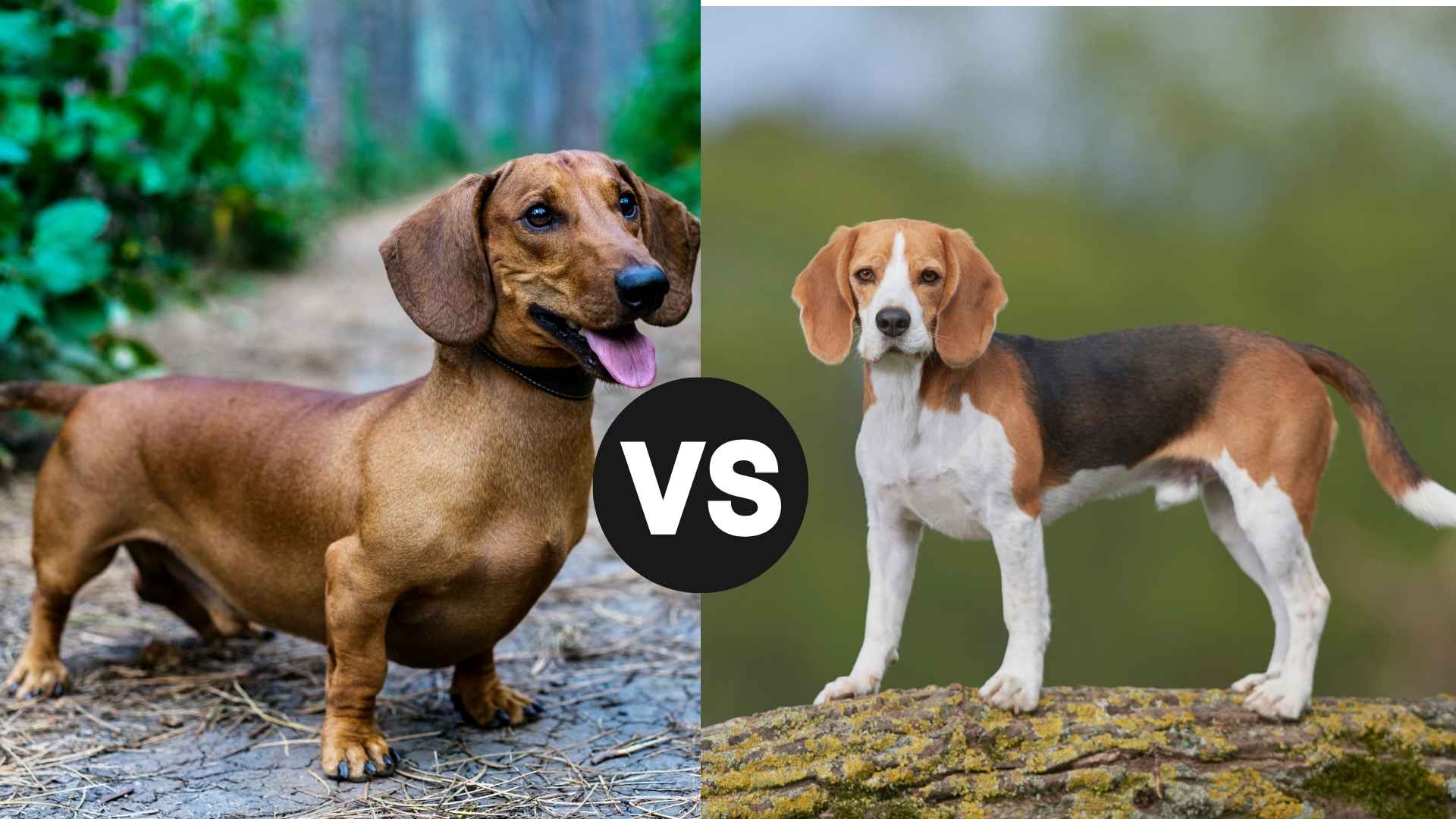When it comes to small hound breeds with giant personalities, beagles and dachshunds are top contenders—and choosing between them is no easy feat. One is long and low with a nose for digging and drama; the other is a floppy-eared detective with a heart of gold and an appetite for adventure. Both are irresistibly charming, endlessly curious, and beloved around the world—but they offer very different experiences as pets.
The Dachshund, affectionately known as the “wiener dog,” is bold, stubborn, and incredibly loyal. Beagles, on the other hand, are pack-oriented, cheerful, and often led by their noses—sometimes straight into mischief.
If you’re trying to decide which of these iconic breeds is right for you, you’re in the right place. This article dives into a side-by-side comparison of the Beagle vs Dachshund—from temperament and training to health and lifestyle. Whether you want a spunky shadow or a sociable explorer, we’ll help you find your perfect match.
Dachshund vs. Beagle
Dachshund vs. Beagle: Physical Characteristics
When comparing the physical characteristics of the Dachshund and Beagle, it’s clear that these two breeds, while both small and energetic, have distinct features.
Size and Body Shape
Dachshund
As per Purina, nicknamed “wiener dogs,” this funny and vivacious breed was originally developed in Germany over 300 years ago to hunt badgers. These badger dogs are known for their unique, long body and webbed feet.
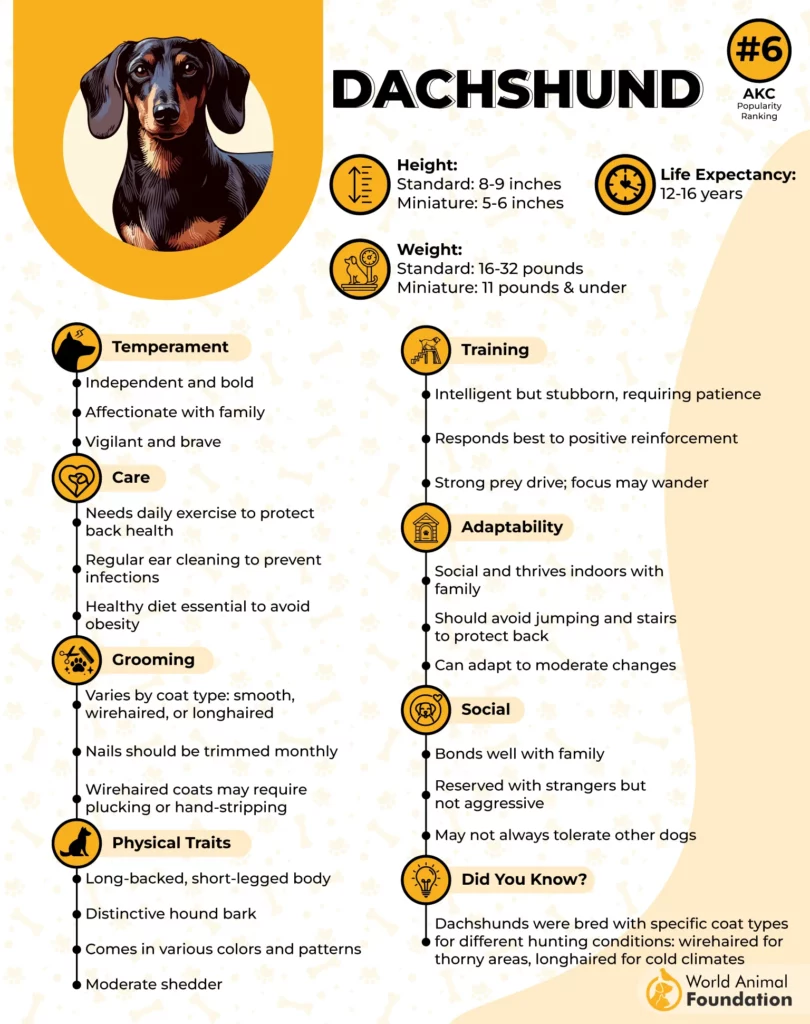
This popular breed typically weighs between 8-32 pounds, depending on whether it’s the standard or miniature variety. Their height usually ranges from 5 to 9 inches at the shoulder.
Their long, sausage-like, elongated bodies are one of their most recognizable traits, with a deep chest and a narrow midsection. The short, stumpy legs contribute to their signature low-to-the-ground appearance.
Beagle
Slightly larger, Beagles typically weigh between 20-25 pounds and stand around 13 to 15 inches tall at the shoulder.
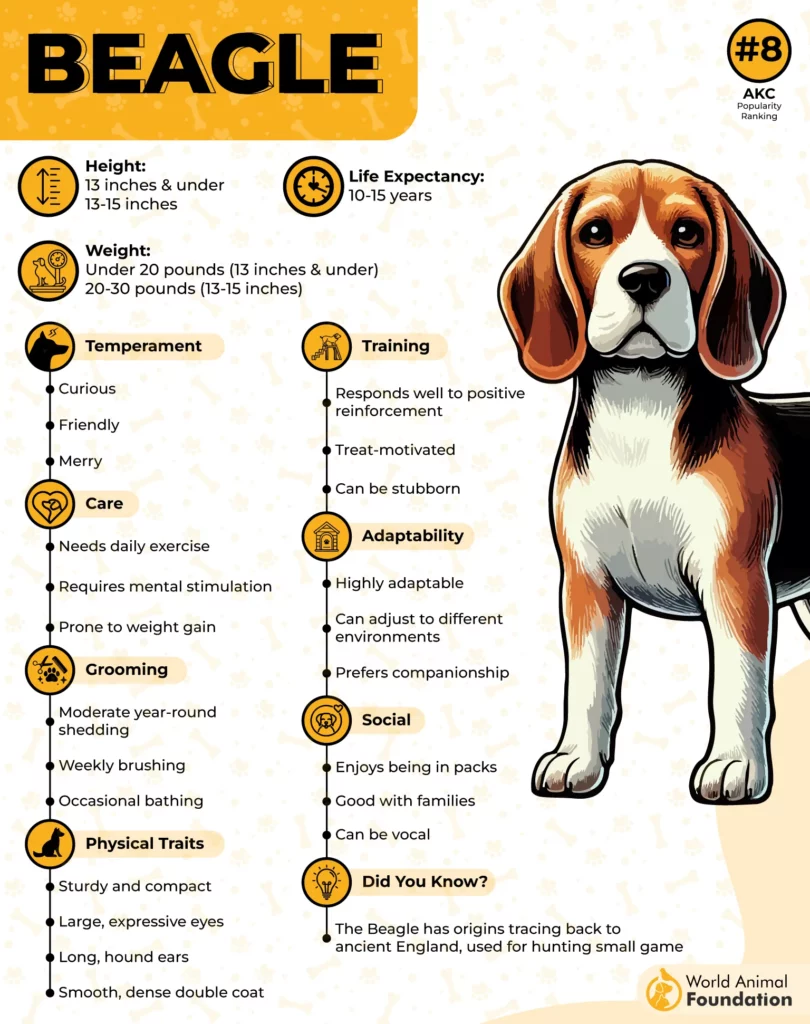
Beagles have a more compact, muscular build with a square body shape. Their legs are longer than the Dachshund’s, giving them a more balanced and proportional appearance.
Coat and Color
Dachshund
Dachshunds have three coat types: longhaired, wirehaired, and smooth-haired dachshunds. The smooth variety has a short, sleek coat, while the long-haired dachshund has a softer, longer coat, and the wirehaired dachshund features a coarser, more textured coat.

Their color varies, including red, black, and tan, blue, tan, fawn, cream chocolate, and dapple.
Beagle
Beagles usually have dense, short coats that are easy to maintain. They often come in tri-color (black, white, and tan), lemon (light tan and white), or bi-color combinations.

Ears and Tails
Dachshund
They have long, droopy ears that are a bit wider at the base, giving them an endearing, soft expression.
The tail of a Dachshund is typically medium in length, with a slight upward curve. It’s usually held high and can be seen wagging in excitement.
Beagle:
The Beagle’s tail is straight or slightly curved and is often seen held high, with a characteristic “flag” motion as they wag it.
Beagles also have long, floppy ears, but they are more rounded and tend to hang lower along the sides of their heads.
Both breeds have their own charm, with the Dachshund’s long, low body contrasting with the Beagle’s sturdier and more athletic build. The differences in size and shape play a big role in how they interact with their environments and their ability to perform specific tasks like hunting or agility activities.
Dachshund vs. Beagle: Personality
While both the Dachshund and Beagle share a love for fun and adventure, their personalities have some key differences that may influence which breed fits better with a particular lifestyle.
Dachshund Temperament
Bold, curious, confident, and independent. Can be stubborn and sometimes acts as if they’re in charge. Loyal to their family, but can be wary of strangers.

Energy Level
Moderately active with bursts of energy. Enjoys exploring and sniffing around, often during long walks, but also loves lounging and relaxing.
Socialization
Can be reserved or protective around strangers. Affectionate and loving with family members, but early socialization is important.
Vocalization
Can be quite vocal, barking at strangers, noises, or when excited. Their bark is loud for their size, and they may also whine or yap.
Affection Level
Loyal and affectionate nature, often forming a strong bond with one person in the household. Prefers to be the center of attention.
Beagle Temperament
Friendly, outgoing, and social. Generally even-tempered and great with people and other dogs. A gentle disposition makes them excellent family pets.
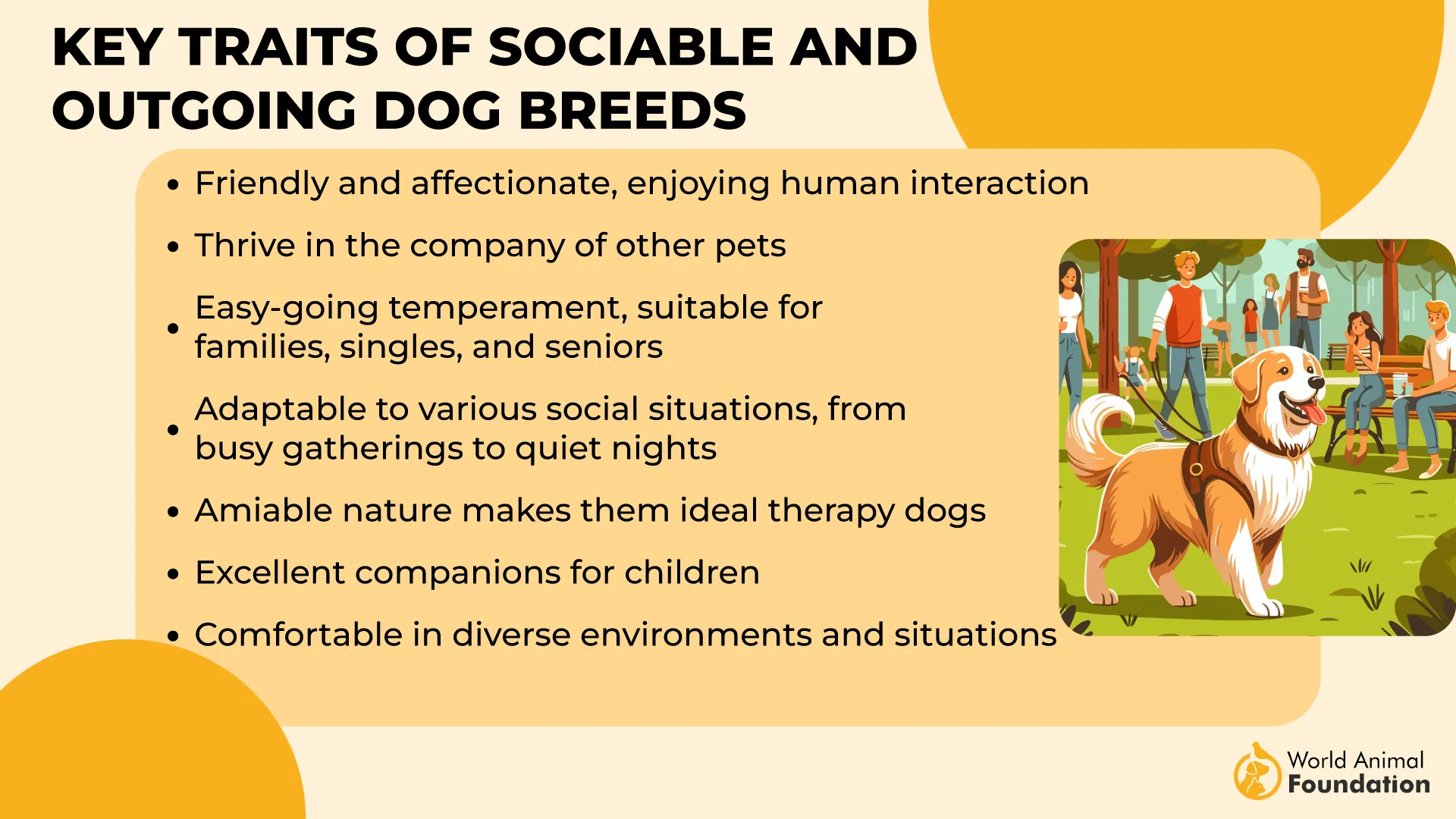
Energy Level
High energy, requiring regular exercise and outdoor play, as well as attention to their vocal nature. Active and curious, particularly because of their strong sense of smell.
Beagles are hunting dogs and scent hounds, so don’t be surprised if they get distracted while out and refuse to pay attention. As pack dogs, they also have a strong love for their canine companions.
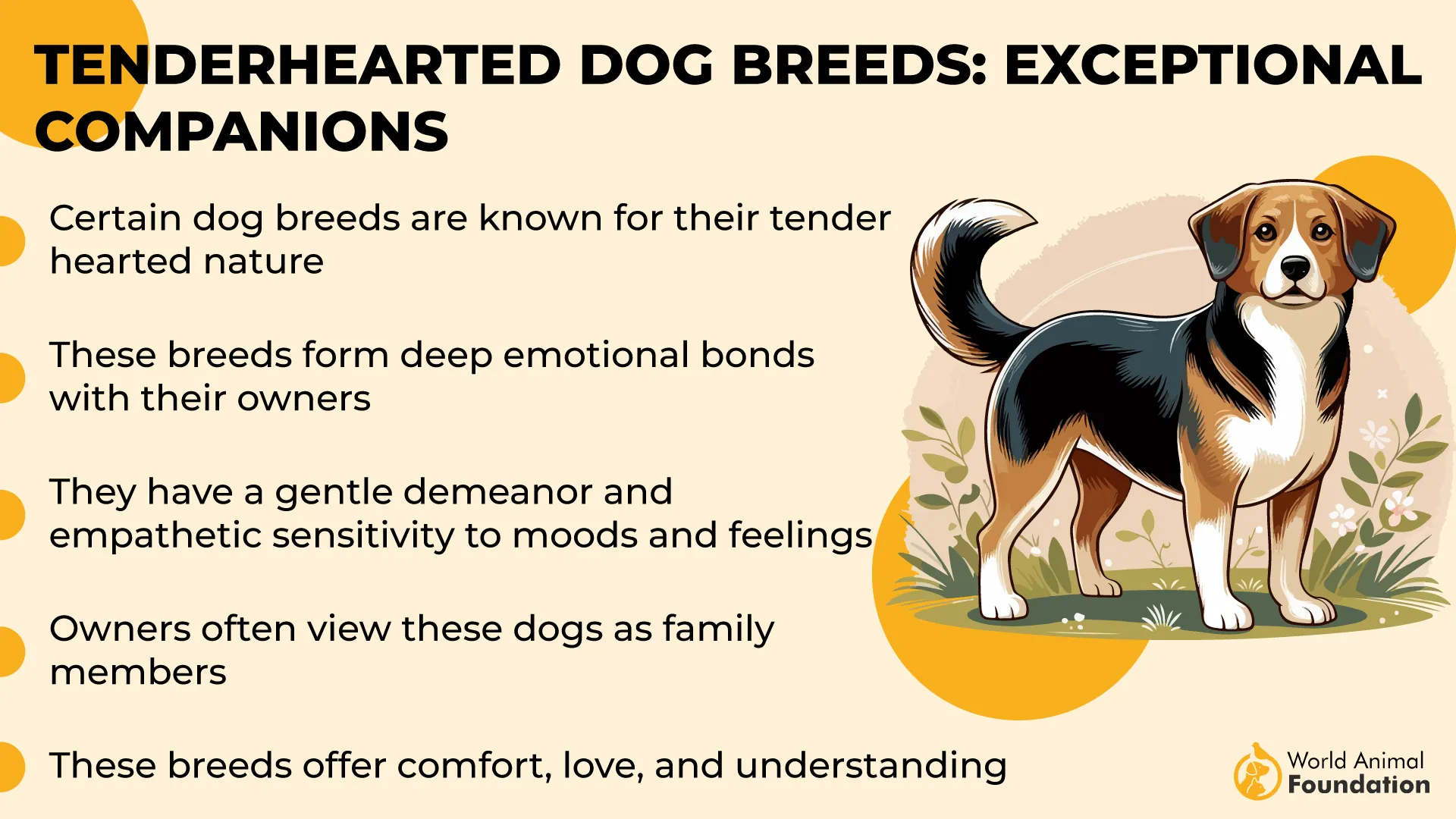
Socialization
Very social dogs who enjoy the company of both people and other dogs. Great for multi-pet households and families with children.
Vocalization
Known for being vocal, with a distinctive melodic bark. Can also howl, especially when bored or lonely.
Affection Level
Loving and eager to please. Beagles love forming strong bonds with family members and enjoy following them around, seeking attention.
If you’re looking for a more independent and slightly lower-energy companion, the Dachshund might be a better fit. If you want a more social, playful dog with higher energy, the Beagle could be your ideal match, as they are known to be excellent companions.
Dachshund vs. Beagle: Trainability & Intelligence
When comparing the trainability and intelligence of Dachshunds and Beagles, both breeds have unique traits that influence how they respond to training and learn new tasks.
Dachshund

Dachshunds are intelligent dogs, but they often prefer to do things on their own terms. While dachshunds excel in learning commands and tasks, they are more independent-minded and can sometimes have a bit stubborn streak.
Because of their independent nature, Dachshunds can be challenging to train. They may get distracted easily and may not always follow commands unless they see a personal benefit. Positive reinforcement and consistent training are key to getting the best results.
Training Challenges
Dachshunds have a tendency to be persistent and independent, which can make them less eager to please compared to other breeds. They may also be prone to being a bit stubborn, which means patience and repetition are required to teach new commands.
According to PDSA, because Dachshunds are so clever, it is possible to train them not to bark excessively for no reason, but this training should begin at an early age.
Best Training Approach
Using treats and praise to motivate them works best. Keeping training sessions short and fun can help prevent them from losing interest.
Beagle

Beagles are also intelligent, but their strong sense of smell can sometimes make them more interested in following scents than paying attention to commands. Despite this, these cute dogs are quick learners and can pick up commands with the right motivation.
Beagles are generally easier to train than Dachshunds due to their eagerness to please and desire to work alongside their owners. However, their independent streak and curious nature can sometimes get in the way during training, especially when distracted by scents.
Training Challenges
Beagles can be stubborn and difficult to focus, particularly when they get caught up in a scent trail. They can be persistent, which is useful for hunting but may make them a little harder to train in everyday situations.
Beagle puppies should be socialized from an early age to develop into well-mannered and confident adults.
Best Training Approach
Beagles respond well to food-based rewards and praise. Consistency is key, and using positive reinforcement will help keep them focused. Incorporating plenty of playtime can keep them engaged and happy during training.
Dachshund vs. Beagle: Health Considerations
When comparing the health considerations of Dachshunds and Beagles, both breeds have their own set of potential issues.
Dachshund Common Issues

Due to their long spine and short legs, Dachshunds are prone to back problems, particularly intervertebral disc disease (IVDD), which can lead to pain and mobility issues. It’s important to avoid activities that put undue strain on their back.
Dachshunds tend to gain weight easily, especially if not properly exercised or if they’re overfed. Obesity can exacerbate back issues and lead to other health problems, like joint issues and diabetes.
Like many small dogs, Dachshunds are prone to dental issues, including gum disease and tooth decay. Regular dental care is essential to maintain oral health.
Though less common than in larger breeds, Dachshunds can still develop hip dysplasia, a condition where the hip joint doesn’t develop properly, leading to pain and mobility issues.
Beagle Common Issues

Beagles can be prone to hip dysplasia, which can cause pain and stiffness in the joints. Regular exercise and maintaining a healthy weight can help manage this condition.
Beagles have a higher incidence of epilepsy compared to other breeds, which can lead to seizures. While the condition can often be managed with medication, it requires regular veterinary monitoring.
Due to their long, floppy ears, Beagles are more prone to ear infections. Regular ear cleaning and keeping their ears dry can help prevent these infections.
Beagles are food-driven and can easily become overweight if not properly monitored. Obesity can lead to joint problems, diabetes, and a reduced lifespan.
Beagles may be prone to hypothyroidism, where the thyroid gland doesn’t produce enough hormones, leading to weight gain, lethargy, and other symptoms.
Dachshund vs. Beagle: Lifespan
Dachshunds typically have an average lifespan of 12 to 16 years, with some even reaching beyond that if they are well cared for. Their relatively long lifespan is attributed to their small size, which generally contributes to fewer health complications compared to larger breeds. Dachshunds can live longer with careful management of their weight and protection from back injuries, which are common in the breed due to their elongated spine.
Beagles generally live between 12 to 15 years. They have a reputation for being a hardy breed, though their lifespan can be influenced by factors such as diet, exercise, and genetic predispositions. Regular vet check-ups and proper care, along with a healthy lifestyle, can help Beagles live their full lifespan. Their playful nature and high energy levels often keep them active well into their senior years.
Conclusion
In the colorful and diverse dog world, choosing between a Dachshund vs. a Beagle can feel like a delightful challenge. Both dog breeds have unique strengths that make them beloved by pet owners around the globe. Whether it’s the long-bodied charm and bravery of the Dachshund or the curious nose and friendly energy of the Beagle, each dog brings something special to the table.
While both Beagles are known for their keen sense of smell and loyal nature as a hunting dog, not all Beagles are created the same—some are more independent, while others are highly affectionate and eager to please. On the other hand, Dachshunds, with their bold personalities and cleverness, also thrive as loving canine companions who demand affection, attention, and plenty of mental stimulation from their owners.
When it comes to health, healthy dogs of both breeds can enjoy long, happy lives if properly cared for. Ultimately, your choice depends on your lifestyle, patience for training, and desire for companionship. Are you drawn to the stubborn yet comical Dachshund or the merry, determined Beagle?


